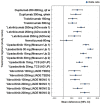Moderate to severe atopic dermatitis in children: focus on systemic Th2 cytokine receptor antagonists and Janus kinase inhibitors
- PMID: 37321570
- PMCID: PMC10839191
- DOI: 10.3345/cep.2022.00346
Moderate to severe atopic dermatitis in children: focus on systemic Th2 cytokine receptor antagonists and Janus kinase inhibitors
Abstract
Atopic dermatitis (AD) is a lifelong disease that markedly impairs quality of life. AD is considered a starting point of the "atopic march," which begins at a young age and may progress to systemic allergic diseases. Moreover, it is strongly associated with comorbid allergic and inflammatory diseases including arthritis and inflammatory bowel disease. Understanding the pathogenesis of AD is essential for the development of targeted therapies. Epidermal barrier dysfunction, immune deviation toward a T helper 2 proinflammatory profile, and microbiome dysbiosis play important roles via complex interactions. The systemic involvement of type 2 inflammation, wheather acute or chronic, and whether extrinsic or intrinsic, is evident in any type of AD. Studies on AD endotypes with unique biological mechanisms have been conducted according to clinical phenotypes, such as race or age, but the endotype for each phenotype, or endophenotype, has not yet been clearly identified. Therefore, AD is still being treated according to severity rather than endotype. Infancy-onset and severe AD are known risk factors leading to atopic march. In addition, up to 40% of adult AD are cases of infancy-onset AD that persist into adulthood, and these are often accompanied by other allergic diseases. Therefore, early intervention strategies to identify high-risk infants and young children, repair an impaired skin barrier, and control systemic inflamation may improve long-term outcomes in AD patients. However, to the best of our knowledge, no study has evaluated the effectiveness of early intervention on atopic march using systemic therapy in high-risk infants. This narrative review addresses the latest knowledge of systemic treatment, including Th2 cytokine receptor antagonists and Janus kinase inhibitors, for children with moderate to severe AD that is refractory to topical treatment.
Keywords: Atopic dermatitis; Biological products; Child; Cytokines; Etiology; Janus kinases; Therapeutics.
Conflict of interest statement
No potential conflict of interest relevant to this article was reported.
Figures





Similar articles
-
Oral Janus kinase/SYK inhibition (ASN002) suppresses inflammation and improves epidermal barrier markers in patients with atopic dermatitis.J Allergy Clin Immunol. 2019 Oct;144(4):1011-1024. doi: 10.1016/j.jaci.2019.07.013. Epub 2019 Jul 26. J Allergy Clin Immunol. 2019. PMID: 31356921 Clinical Trial.
-
Multiple Roles for Cytokines in Atopic Dermatitis: From Pathogenic Mediators to Endotype-Specific Biomarkers to Therapeutic Targets.Int J Mol Sci. 2022 Feb 28;23(5):2684. doi: 10.3390/ijms23052684. Int J Mol Sci. 2022. PMID: 35269828 Free PMC article. Review.
-
Intrinsic atopic dermatitis shows similar TH2 and higher TH17 immune activation compared with extrinsic atopic dermatitis.J Allergy Clin Immunol. 2013 Aug;132(2):361-70. doi: 10.1016/j.jaci.2013.04.046. Epub 2013 Jun 15. J Allergy Clin Immunol. 2013. PMID: 23777851 Free PMC article.
-
From Skin Barrier Dysfunction to Systemic Impact of Atopic Dermatitis: Implications for a Precision Approach in Dermocosmetics and Medicine.J Pers Med. 2022 May 28;12(6):893. doi: 10.3390/jpm12060893. J Pers Med. 2022. PMID: 35743678 Free PMC article. Review.
-
Regulatory T Cell-Targeted Immunomodulatory Therapy for Long-Term Clinical Improvement of Atopic Dermatitis: Hypotheses and Perspectives.Life (Basel). 2023 Aug 1;13(8):1674. doi: 10.3390/life13081674. Life (Basel). 2023. PMID: 37629531 Free PMC article. Review.
References
-
- Somanunt S, Chinratanapisit S, Pacharn P, Visitsunthorn N, Jirapongsananuruk O. The natural history of atopic dermatitis and its association with Atopic March. Asian Pac J Allergy Immunol. 2017;35:137–43. - PubMed
-
- Kage P, Simon JC, Treudler R. Atopic dermatitis and psychosocial comorbidities. J Dtsch Dermatol Ges. 2020;18:93–102. - PubMed
LinkOut - more resources
Full Text Sources

